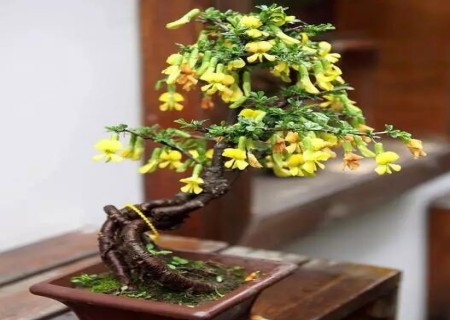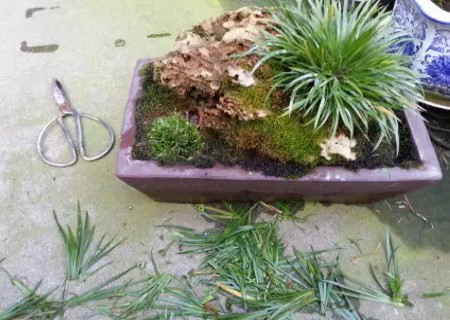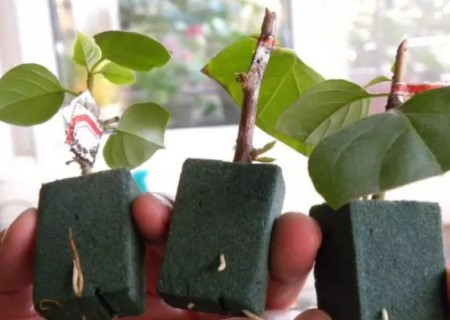The modeling method of broom bonsai dew root
The broom is famous for its blooming birds that flutter its wings and bring vitality to the environment with bright and moving colors. The root system of the canary is Qiu qu strong, and good toughness, easy to twist shape, is an excellent tree species for the production of bonsai. Therefore, the canary bonsai can watch not only the flowers, but also the roots.

In recent years, canary bonsai is more and more favored by modern families, bonsai trees are of different sizes, bonsai can also see big in the small, alone into a forest; what is more, its base is intertwined, vigorous and majestic, giving people a kind of pleasing enjoyment, with very high ornamental value and artistic effect. So, how do broom bonsai shape the root system? Broom bonsai root modeling method is generally root exposure treatment, the following editor for you to share a few root modeling methods.
1. Sleeve type
For some broom bonsai trees which are difficult to sprout adventitious roots, we can achieve the purpose of rooting by means of sleeves after their crowns are trimmed and shaped. Generally, the girdling treatment is carried out on the branches at a certain height from the basin surface, first peeling the bark, then peeling the trunk once, and then sleeving the ring with a section of plastic bottle. Put some bacon soil into the tube, then replenish and moisturize it in time, and then remove the sleeve in about 2-3 years.
After removing the sleeve, we can find that many roots of different sizes have grown in the sleeve, but we can't keep all of them at this time. We need to keep the roots that grow sturdy and somersault upwards. roots that drill down into the basin soil. Of course, we also need to keep some of the relatively small roots that grasp the ground downward, so that they can hold each other like dragon claws.
Second, pile-up type
For the trunk can sprout many adventitious broom bonsai trees, we can achieve the purpose of root shape by piling soil. This method is usually carried out in spring, where artificial scratches can be made at a certain height on the trunk, then bacon soil is piled outside the wound, and then watered to keep the bacon soil moist to facilitate root germination.
Similarly, after about 2-3 years, when we dig up the bacon soil, we will find that the germinated new roots have gradually aged. At this time, we can trim these roots according to our personal preferences to make them more in line with the characteristics of art. At the same time, it also achieves the purpose of revealing roots.
Third, the root type.
Root lifting is a kind of root modeling process carried out in order to make the bonsai of trees have better artistic display and ornamental value. After Tigen, the bonsai tree looks more simple and vigorous, and at the same time it looks old and more artistic.
Broom bonsai can also be used to lift the root to achieve the purpose of root shape, but it is generally combined with changing the basin, and it is raised year by year, and it must not be raised too high at once, otherwise it will affect the survival and growth of trees. The purpose of Tigen is to make the roots of the canary exposed on the basin as much as possible, and at the same time, we should also keep the roots as thin and strong as possible, and keep the strange roots as much as possible. In this way, we can create a unique and unique golden finch root plastic art, which can double the value of the bonsai.
Time: 2019-06-08 Click:
- Prev

How to trim the grass?
Calamus potted plants are often loved by friends because they can bring lush greenery to the home environment. With everyone's understanding of calamus, more and more friends join the ranks of potted calamus. Raising several calamus plants in pots at home can not only make people feel the natural atmosphere, but also see the taste of the owner.
- Next

The method of cutting triangular Plum with Flower paste
As flower paste is recognized by more and more potted friends, it is more and more widely used in flower arrangement, but flower mud can not grow plants. Because the flower paste does not have the function of traditional soil and contains no nutrients, it is mainly used for fixing cut flowers and moisturizing. Even so, flower paste can be used for cutting. that
Related
- Fuxing push coffee new agricultural production and marketing class: lack of small-scale processing plants
- Jujube rice field leisure farm deep ploughing Yilan for five years to create a space for organic food and play
- Nongyu Farm-A trial of organic papaya for brave women with advanced technology
- Four points for attention in the prevention and control of diseases and insect pests of edible fungi
- How to add nutrient solution to Edible Fungi
- Is there any good way to control edible fungus mites?
- Open Inoculation Technology of Edible Fungi
- Is there any clever way to use fertilizer for edible fungus in winter?
- What agents are used to kill the pathogens of edible fungi in the mushroom shed?
- Rapid drying of Edible Fungi

